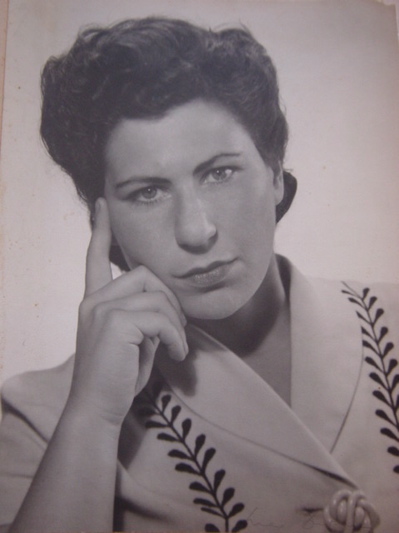 |
Ruth Faerber was born in Sydney, in 1922. Ruth’s interest in the arts was sparked in her youth, during her time at Ravenswood Methodist Ladies College. Encouraged by her teacher Gladys Gibbons to think and work creatively, she left school early to start classes with Peter Dodd’s art school, to train as a commercial artist. Ruth worked for the Market Printery, where she could apply her skills in printmaking.
Studying with Desiderius Orban from 1944 to 1947 and then periodically until 1961was a “breath of fresh air” for Ruth Faerber. Orban, with his background as a European contemporary artist, emphasised tone, bigness of form and simplicity of statement and encouraged the use of all different materials for creating art. During that time, Ruth was also taught by John Olsen and John Ogburn, who held weekly painting classes at the Orban school. (Photo: Ruth Faerber by Max Dupain, 1947) |
In 1967, Faerber won a scholarship to the Pratt Graphics Center in New York. This proved to be pivotal both for Faerber and Australian lithography: she was the first Australian artist to use spray paint in lithography. Ruth brought back not only the latest technical trends in printmaking, but also new imagery and artistic practice. This led to Ruth Faerber being considered one of Australia’s leading lithographers of the 1970s.
From 1970 onwards, Ruth Faerber wrote art reviews for the “Australian Jewish Times”, and from 1973 to 1976, she also studied part-time at the University of Sydney to obtain a broader knowledge of the history of art.
From the 1980s – already in her 60s – Ruth Faerber created her highly distinctive cast bas-relief paperworks. She developed this technique herself, based on her experience in printmaking. These “paperworks”, executed mainly in the form of series works from the early 1980s until the early 2000, explore the human condition in history and present. The technique and the artistic expression are unique in Australian art – wholly Ruth Faerber’s own way of communicating her art and view of the world.
As with many of her artwork, they are inspired by Ruth Faerber’s travels: e.g. The Woman of Pompeii series from 1985, exhibited at Bloomfield Gallery, Sydney, The Jerusalem Series, shown 1989 at Bonython Gallery or the Voice of the Ancestor Series, exhibited 1994 at Blaxland Gallery.
In 2006, the National Gallery of Australia, and in 2007 the Mosman Regional Gallery and Burnie Regional Gallery accepted the donation of numerous works by Ruth Faerber under the Cultural Gifts Program.
Ruth Faerber continues her art practice today by exploring the latest technology to create intriguing digital images.
She is represented by Artarmon Galleries.
Exhibitions
From 1964 onwards, Ruth Faerber has had more than 35 solo exhibitions in Sydney, Melbourne and Canberra, New Zealand and London, and participated in many group shows, including the International Print Biennales in Bradford UK, 1968 and 1982, Australian Paperworks at the International Paper Congress, ’83, Kyoto; First International Paper Biennale, Duren, Germany, 1986. 1991: Workshop Arts Centre, Willoughby NSW, first survey exhibition of Faerber’s work from 1960-1970s. 2001, Hardware Fine Art, Naremburn: second decade of paperworks 1991-2001.
Awards
1967 Scholarship, Pratt Centre. 1974 Commission, PCA Member Print Edition. 1975 and 1981 Exhibition Grant, VAB Australia Council. 1972 – 1984 23 painting and 20 graphics awards. 1987 Artist-in-Residence Bezalel Art Institute, Jerusalem. 2nd Prize Kulturakedemien Harnosand, Sweden 1989. Japan and Mexico 1990.
Represented
National Art Gallery of Australia, Art Galleries of NSW, Victoria, Queensland, South Australia, Tasmania, Mosman Regional Gallery, Burnie Regional Gallery, Print Council of Australia, Dept. of Education, Victoria, private collections such as BHP, Transfield, Artbank and Thyssen-Bornemisza.
Teaching
